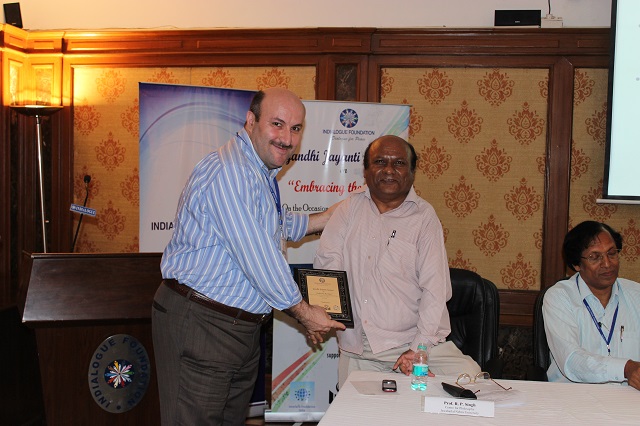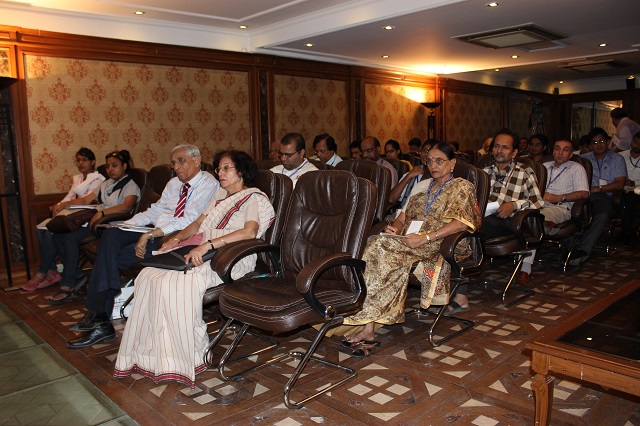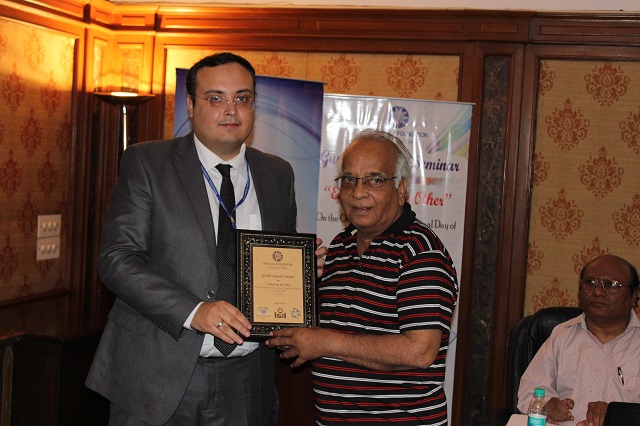Contemporary world is plagued with various problems like xenophobia, terrorism and violence. Civil society organizations in New Delhi organized the Gandhi Jayanti Seminar on “Embracing the Other” on the occasion of the International Day of Non-Violence on 2nd October 2014 at Indialogue Center, Greater Kailash 2, New Delhi. The Seminar was not only an intellectual page out of different interdisciplinary approaches but also propounded various concrete and pragmatic way of “Embracing the Other”.
The Seminar built upon the ideas of Mahatma Gandhi and discussed the practical significant and implication of his ideas in every walk of life.
The participants talked about the political issues like rights of others, strangers, aliens, enemies etc so via Gandhian notions of friendship, forgiveness and cosmopolitanism.
The Seminar also came up with ideas like how to transmute the socio-economical status of society by understanding the Other; acknowledging their presence and looking for the possibilities to embrace Others viz-avir notions like forgiveness, forgetfulness, friendship, reconciliation to attain sustainable peace in the world.
The Seminar was organized by Indialogue Foundation and supported by Interfaith Foundation India, Islamic Studies Association & Global Peace Foundation India. During Seminar 18 papers were presented touching upon various aspects of “Embracing the Other”.
Here are some important points from papers, suggestions, observations and reflections which were shared by paper presenters during Seminar:
Prof. R.P. Singh, Centre for Philosophy, School of Social Sciences, Jawaharlal Nehru University:
 The philosophic notion of ‘the other’ emerged in the process of the emergence and development of ‘identity’ which meant ‘the same’.
The philosophic notion of ‘the other’ emerged in the process of the emergence and development of ‘identity’ which meant ‘the same’.- ‘Identity’ has various dimensions out of which the culture is one of it.
- Culture gives rise to affinity and thereby ‘identity’ in the spheres of language, history, geography, people, art, architecture, etc.
- The purpose of citizenship is not to strengthen national sentiment but to recognize cultural diversity.
- The concept that the self requires ‘the other’ to define itself is an old one and has been expressed by many writers.
- In Buddhism, the other is appreciated with a sense of compassion. The compassion or karunā is understood to mean active sympathy or a willingness to bear the pain of others.
- Violence could be of many kinds – individual and social, physical and psychological, structural and behavioural, economic and political, cultural and civilisational, etc.
- “An eye for an eye makes the whole world blind” Gandhi
- “Satyagraha” literally means holding to truth. In practice, it is nonviolent action to resolve social as well as individual conflicts.
Prof. Hema V. Raghavan, Senior Fellow, Institute of Advanced Studies in Education, Rajasthan:
- All major conflicts arise out of the clash with ‘the other’ and ‘embracing the other’ is one of the greatest challenges for every human being.
- Gandhi led nationwide campaigns for easing poverty, expanding women’s rights, building religious and ethnic amity, ending untouchability and above all for achieving Swaraj or self-rule.
- “I object to violence because when it appears to do good, the good is only temporary; the evil it does is permanent. Anger and intolerance are the enemies of correct understanding.” Gandhi
- “You must not lose faith in humanity. Humanity is an ocean; if a few drops of the ocean are dirty, the ocean does not become dirty.” Gandhi
- Gandhiji stood like a colossus who had the capacity to give and receive strength and whose words and action strongly influenced the freedom movement. He had no hatred even for the few misguided groups that took to violence.
- The greatness of human beings, he said, did not lie in reshaping the world as according to their perception, but in their ability to remake themselves according to the demands of the world.
- One of the best ways of generating trust is through dialogue. It is in the dialogue that we can open ourselves to the otherness of the persons we meet and interact at different phases of our lives.
- “There are a you and an I, and there is no mine and yours! For without a you and an I, there is no love, and with mine and yours there is no love but “mine” and “yours” Soren Kierkegaard.
Prof. Subhash Chandra, Board of Trustee, Global Peace Foundation:
- According to Indian philosophy Ahimsa is higher consciousness i.e. Peace Consciousness and Himsa means Violence, hurtfulness, is lower consciousness i.e. violent consciousness.
- “There is no way to peace, peace is the way.” Gandhi
- The ‘Chakra’ is the Sanskrit word for “Wheel”. The ‘Chakra (Wheel)’ is the symbol of Life and ‘Shanti Chakra’ is Wheel of Peace.
- ‘Shanti Chakra’-Eight Global Values for Peace & Harmony: Tolerance, Forgiveness, Cooperation & Respect, Love & Compassion, Purity, Truth & Intuition, Peace and Unity.
- Peace education includes the cultivation of peace building skills (e.g. dialogue, mediation, artistic endeavors).
- Gandhiji advocates Values & Ethics for Sustainable Future& described the seven social sins for the society: “Wealth without work, Pleasure without conscience; Knowledge without character, Business without Ethics; Science without Humanity, Religion without Sacrifice and Politics without Principles are deadly Sins.”
General Pramod Saighal. Retired Indian Army General:
- A perceptive mind absorbs and assimilates the impending difficulties and the likely trauma that would face mankind if appropriate correctives in the form of mega peace initiatives are not undertaken world-wide and invariably starts working in that direction. This doubly reinforces the locus and the focus of such efforts. It is extremely important to remain connected. Dialogue as against confrontation should be the preferred mode of human interaction. We need to listen more; discourage divisive politics and stop confronting one community or religious group against other community or religious group. These need to be embedded in our psyche from our very childhood.
- India continues to be singularly fortunate that it, time and again, throws up Rishis, sages, Acharayas and reformers who through their humility, humbleness, exceptional wisdom and far-sightedness guide it through tortuous times. Swami Vivekananda, Swami Dayanand Saraswati, Sri Aurobindo, Pandit Shri Ram Sharma of Shantikunj, Jai Prakash Narain and Vinoba Bhave are some of the more contemporary examples that readily come to my mind. There are many more whose names I cannot conjure up at this point of time.
- The relevance of Gandhian ideals in the present day milieu stood clearly established. Many a speaker directly or indirectly referred to their usefulness. In fact, non-violence needs to be pursued with utmost vigour; lest the cycle of violence, retribution and renewed violence eventually goes on to strengthen animal spirits of man as against the benign, peaceful nature that God has gifted us with.
- The seminar was simply scintillating in every respect. It not only enriched us, but gave us an opportunity to share thoughts, views, perceptions, excitements and experiences. Should some of the ideas that were thrown up, be carried to their logical conclusion by Govts, NGOs, Religious Groupings or even concerned individuals, the world may perhaps be a little more livable than today. To that extent usefulness of such seminars stands established beyond an iota of doubt. They help us remain connected and informed.
Dr M. D. Thomas, Director at Institute of Harmony Studies:
- ‘Embracing’ would mean ‘holding someone closely in one’s arms, especially as a sign of affection’.
- God reaches out to all humanity and he makes it through ways known to him alone.
- It is the willingness to tolerate the existence of opinions or behaviour that one dislikes or disagrees with.
- As per the Constitution of India, equal opportunities are allotted to all religious traditions to practice, propagate and grow.
- Interaction or dialogue necessitates one to open up to the other. It is a positive attitude of goodwill towards the other.
- The word ‘harmony’ means integration, co-ordination, unity, balance, etc. The Hindi synonym for the word harmony is ‘samanvay’ and it has two parts, ‘anvay’ and ‘sam’.
- The word ‘harmony’ is grounded in the world of music. It is the ‘pleasing effect’ that emerges from a group of musical sounds as they are sounded all together. A single note cannot produce harmony.
- It is observed that people have more reservation in embracing the other in religions. Therefore the understanding of other faith has to be broadened. As the divine is one, so is faith, though it has many dimensions.
- One has to deepen the knowledge about the faith of the other.
- One has to acquire knowledge of the faith of the other
- One has to have good will towards the other believers.
- One has to respect, accept, embrace and remain in harmony with the other believers. Faith is a joint journey to the divine, together with the other.
- One has to empower oneself in seeing God reflected in the other human being.
Abdur Rahman, Ph.D. Scholar, Centre for Arabic and African Studies, Jawaharlal Nehru University, New Delhi:
- “You should definitely know that the highest aim of the human’s innate character (khilkat) and the most sublime result of the human’s inborn disposition (fitrat) are to have faith in God. And the most exalted position and the greatest status in the ranks of humanity are to attain the knowledge of God within faith in God. The most delightful happiness and the sweetest bounty for Jinn and human beings are to attain the love of God within the knowledge of God. The purest joy for the human spirit and the finest pleasure for the human heart are to experience the spiritual taste contained within the love of God. Surely, all true happiness, pure joy, pleasant bounty, and sheer taste are all found in and experienced through the knowledge of God and the love of God” Nursi
- From Nursi’s standpoint, the worst type of misguidance is forgetting one’s self due to the disconnection of one’s faith-bond with the Creator.
- “Faith necessitates affirmation of Divine unity, which in turn necessitates submission to God, which in turn necessitates reliance on God, which in turn necessarily leads to happiness in this world and the next”. Nursi
Adrian J. Fernandes, Masters in Theology, (MTh), Institute of Philosophy and Religion, Jnana-Deepa Vidyapeeth, Pune:
- Eating together, being together and sharing from the same preparation builds bonds and deepens the commonality of a shared identity.
- Guru ka Langar (literally meaningGuru’s communal dining-hall) is a community kitchen run in the name of the Guru, usually attached to a gurudwara. Guru Nanak, the first Guru of Sikhism, started this communal meal, the Langar (Hindi: लंगर) which has served two primary intended purposes; firstly in fostering the principle of equality between all peoples of the world regardless of religion, caste, colour, creed, age, gender or social status and secondly to put into practice the spirit of humble, selfless social service, thus expressing the ethics of sharing, community living, inclusiveness and oneness of all humankind.
- Pangat literally means a ‘same row’. It stands for people sitting and eating together in the same row during the Gurukalangar.
- Jesus reminded his listeners, “Man does not live by bread alone”.
- Both Sikhism and Christianity acknowledge the divine presence in and through the community celebration of the meal.
- Sangat and Pangat bring about the aspects of prayer, reflections, meditation on scriptures and meals shared.
- We are to remind ourselves and understand that the Eucharist and the Langar is a family meal. A family meal is an excellent example of communion and dialogue.
- That like Gandhi, we primarily ought to have a deep sense of awareness and openness to learn, adapt and personalize the basic human values and all that would enhance life and human well-being.
Benazir Banu, M.Phil Scholar, Academy of International Studies, Jamia Millia Islamia:
- Mahatma Gandhi and Turkish War of Independence
- Mahatma Gandhi kept trying to reach the depths of nonviolence, beginning with his own heart and soul. Along with it he introduced a new method of social change, which he called “Satyagraha” (truth force), it means resisting untruth by truthful means.
- Mahatma Gandhi was one of the biggest moral supporters of the Turkish cause when the victorious Allied powers were bent on partitioning Turkey.
- During the First World War the Muslims of India were in very painful dilemma. They were confused between their duty as loyal citizens of the British Empire and as the followers of their religious chief, the Sultan-Caliph of Turkey.
- Gandhi proposed a vow of Hindu-Muslim unity. He claimed that Hindus would give enthusiastic support to Muslims in their just claims regarding the retention of Turkey as a sovereign State with full regard for their feelings as to the holy places and the Khilafat.
- Gandhi’s idea of combining Khilafat movement along with non-cooperation movement is one of the biggest proofs of his dedicated commitment towards the Turkish war of independence and protecting the sentiments of the Indian Muslims linked to their holy places.
- “I am not anti-British, I am not anti-government, but I am anti-truth, anti-humbug and anti-injustice and as long as the government spells injustice, it may regard me as its enemy, implacable enemy.” Gandhi
- The contribution of Gandhi is commonly talked and read in the contest of South Africa and Indian Independence movement. But students in general know very little about Gandhi’s contribution in Turkish way of Independence
Himanshu Sekhar Mishra, Ph.D. Scholar, Jawaharlal Nehru University:
- Gandhi’s definition of conversion means a definite giving up of the evil of the world, adaptation of all the good of the new and a scrupulous avoidance of everything evil in the new. Conversion should, therefore, mean a life of greater dedication to one’s own country, greater surrender to God and greater self purification. For him, conversion is a heart process known only to and by God. It must be left to itself…
- “I do not expect the India of my dream to develop one religion, i.e. to be wholly Hindu, or wholly Christian, or wholly Mussalman, but I want it to be wholly tolerant, with its religions working side by side with one another.” Gandhi
- Difference of religious opinion will persist to the end of time; toleration is only thing that will enable person belonging to different religions to live as good neighbors, friends and cousins.
- He had a strong view that the so-called majority community has no right to impose itself on others… the minorities must be made to realize that they are as much valued citizens of the state they live in as the majority.
- Gandhi’s stance on conversion is founded not on the denial of any rights, e.g., the freedom of choice and freedom to preach; but on his concept of duty, the obligation imposed by one’s dharma.
Mahesh Sharma, Ph.D. Scholar, The English and Foreign Languages University, Hyderabad:
- Democracy is based on equality, liberty and fraternity. Gandhi advocated self rule or self-government as the essence of democracy.
- Notions of the Other and alterity have formed the crux of philosophical debate since the days of Plato.
- The rise of minority studies, animal studies, feminism, post-humanism and queer studies has problematized and reshaped the question of Otherness.
- Concepts such as the coexistence of Self with Others, the relationality, the shift of conflict from Self and Others to conflict within the Self, the sharing of experience, being-in-common, cosmopolitan consciousness, etc. Have altered the basic features of the postcolonial community.
- Leela Gandhi, inspired by M.K. Gandhi’s ‘ethics of conscience’ as captured in the book Hind Swaraj, proposes an ethics of imperfection or imperfect historiography.
Mahima Taneja, Ph.D. Scholar, Jawaharlal Nehru University:
- A common public language can lead to marginalization of linguistic minorities and to prevent such disadvantage, states should accommodate linguistic diversity.
- Patten argues that according to ‘right to linguistic security, minority speakers have a right to protection against ‘unfair or coercive practices’ that threaten to compromise the survival or flourishing of their language.
- Multilingualism is seen as a step towards a multination state.
- Indian experience of federalism suggests that India has been successful in protecting and promoting major national minorities that became state majorities after linguistic reorganization.
- However, interests of internal minorities, i.e., linguistic minorities within states, have not been adequately protected, but attempt have been made to accommodate them.
Mohamed Rafeek K.P., Ph.D. Scholar, Centre for the Study of Social Systems, Jawaharlal Nehru University:
- India, in its all multifarious magnificence, beautifully celebrates this plurality with its “unity in diversity”.
- In the 1920s the Gandhian leadership transformed the freedom struggle into a genuine mass movement that used the methodologies of Satyagraha (nonviolent struggle) in the forms of nonviolent non-cooperation and civil disobedience. Satyagraha used peaceful strikes, marches, demonstrations, sit-ins, hunger strikes and courting imprisonment.
- By avoiding violence and military means, Satyagraha develops rational debate and emphasizes political process.
- Satyagraha built among the masses the habits and behavioural patterns of peaceful discussion, compromises and nonviolent settlement of disputes.
- Satyagraha depends upon open and active participation of the masses consisting of all types of men and women, who possess self-confidence, courage and goodwill to carry on nonviolent campaigns in noncooperation and civil disobedience.
- In India the concept has been used not as state’s indifference meaning towards religion(s) but as treatment of all religions in an equal fashion and ruling out discrimination of any Indian on the ground of his religion.
- Gandhi believed that state while giving fair treatment to all religions, could still maintain equal distance from all religions as well as religious communities.
- The essence of secularism, however, rest on two basic principles: (a) Separation of religion from politics (b) Acceptance of religion as purely and strictly private affair of individuals having nothing to do with the state.
- Gandhi was of the view that there should not be any state religion. “Even if the whole community had one religion, state interference would probably always be unwelcome”.
- Ending feudalism (landlordism) and distributing land among the landless peasantry have produced blood baths, civil wars and military coups in every country. India is only one exception where feudalism was eliminated and peasants were liberated from slavery and exploitation through peaceful Gandhian methods.
Shokanova Rashida, Visiting Professor, Kazakh Language, JamiaMillia Islamia:
- Article is about the great poet, philosopher, thinker, composer, educator of Kazakh people in the nineteenth century Abay Kunanbay.
- In recognition of his talent and services to the whole of mankind, UNESCO announced the year 1995–the year of Abay in the whole world.
- It is known that Abay always dreamed of being not his father’s son, but the son of the Fatherland.
- “A hungry man is not easy to maintain prudence and honor, even more difficult to maintain a constant commitment to the sciences. Only when a person is free from concerns about a piece of bread, he feels the need of knowledge and culture” Abay
- In the name of improving the lives of steppe peoples Abay believed it was necessary to examine closely the life and culture of developing nations.
- In his testament: “Love, my brother, all of humanity,” based not just diplomacy coexistence, and the fundamental principle of unity and brotherhood of all mankind.
- Abay and again inspires us do what others are doing, adopt their culture and science.
- And another of his core tenet: “If Kazakh does not respect Kazakh, then the life ill be hateful around”-is central to our national solvency.
Saidalavi Kundupuzhakkal, Ph.D. Scholar, Faculty of Education, JamiaMillia Islamia:
- Pluralistic society refers a society in which citizens can legally and publicly hold multiple competing ethical views and are allowed to choose for themselves what ethical beliefs they wish to hold.
- Integrated education primarily looks for the group integration as well as the value integration in educational settings. It is assumed that integrated education is more suitable in a pluralistic society than segregated education for promoting cultural co-existence and social cohesion.
- Many countries are practicing integrated education. The concept of integrated schooling was highly effective in Ireland.
- Group integration may be given in the form of multi-caste education, multi-religious education, multi-lingual education, multi-racial education andmulticlass education or altogether.
- If there is a proper interaction among the various ethnic groups, it will help them to understand the similarities and dissimilarities among the group.
- Value integration is the inculcation of various socially accepted values in the educational curriculum. Value integration classified as traditional religious value and modern democratic values.
- A study conducted in Loss Angeles metropolitan area reveals that social integration into the local community significantly reduce feeling of vulnerability and reduce fear of crime.
- Peace education is the process of acquiring the values, the knowledge and developing the attitudes, skills, and behaviors to live in harmony with oneself, with others, and with the natural environment.
- “Peace Education a holistic process that includes the teaching for and about democracy and human rights, nonviolence, social and economic justice, gender equality, environmental sustainability, disarmament, traditional peace practices, international law, and human security”. (Global Campaign for Peace Education, Hague 1999)
- The researcher concludes that the integrated education is more suitable in a pluralistic society than segregated education for promoting cultural co-existence and social cohesion.
Sheetal, Ph.D. Scholar, Department of Political Science, Aligarh Muslim University:
- “The term non-violence signifies the total absence of both “direct” (physical) and “indirect” (structural) forms of violence” Manfred B. Steger.
- “Non-Violence in its dynamic condition means conscious suffering. It does not mean meek submission to the will of the evil-doer, but it means putting of one’s whole soul against the will of the tyrant” M. K. Gandhi 1920.
- According to Martin Luther non-violence is the way of life for courageous people. It seeks to win friendship and understanding. It defeats injustice. Non-violence holds voluntary suffering can educate and transform.
- Another Political Scientist and best known writer on non violent action Gene Sharp defined’ three broad categories of nonviolent action protest, non-cooperation, and intervention. Protest includes such means as demonstrations, marches, and vigils. Non-cooperation involves strikes and boycotts, which may be social, economic, or political in their impact. Intervention includes fasts, nonviolent occupations, and the operation of a parallel government.
- Gene Sharp in his book ‘Waging Nonviolent Struggle’ describes 198 methods of non violent action.
• “The non-violent resister not only refuses to shoot his opponent but also refuses to hate him. At the centre of non-violence stands the principle of love” Martin Luther King Jr.



























